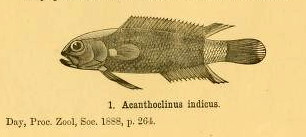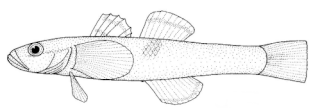
Combtooth blennies are blenniiformids; percomorph marine fish of the family Blenniidae, part of the order Blenniiformes. They are the largest family of blennies with around 401 known species in 58 genera. Combtooth blennies are found in tropical and subtropical waters in the Atlantic, Pacific and Indian Oceans; some species are also found in brackish and even freshwater environments.

The blennioid family Chaenopsidae includes the pike-blennies, tube-blennies, and flagblennies, all percomorph marine fish in the order Blenniiformes. The family is strictly tropical, ranging from North to South America. Members are also present in waters off Japan, Taiwan and Korea. Fourteen genera and 91 species are represented, the largest being the sarcastic fringehead, Neoclinus blanchardi, at 30 cm (12 in) in length; most are much smaller, and the group includes perhaps the smallest of all vertebrates, Acanthemblemaria paula, measuring just 1.3 cm (0.51 in) long as an adult.

Blenny is a common name for many types of fish, including several families of percomorph marine, brackish, and some freshwater fish sharing similar morphology and behaviour. Six families are considered "true blennies", grouped under the order Blenniiformes; its members are referred to as blenniiformids. About 151 genera and nearly 900 species have been described within the order. The order was formerly classified as a suborder of the Perciformes but the 5th Edition of Fishes of the World divided the Perciformes into a number of new orders and the Blenniiformes were placed in the percomorph clade Ovalentaria alongside the such taxa as Cichliformes, Mugiliformes and Gobiesociformes.

Amphibious fish are fish that are able to leave water for extended periods of time. About 11 distantly related genera of fish are considered amphibious. This suggests that many fish genera independently evolved amphibious traits, a process known as convergent evolution. These fish use a range of methods for land movement, such as lateral undulation, tripod-like walking, and jumping. Many of these methods of locomotion incorporate multiple combinations of pectoral-, pelvic-, and tail-fin movement.

The dottybacks are a family, Pseudochromidae, of fishes which were formerly classified in the order Perciformes, but this has been revised and the family is regarded as of uncertain affinities, or incertae sedis within the Ovalentaria, a clade within the Percomorpha. Around 152 species belong to this family.

The longfins, also known as roundheads or spiny basslets, are a family, Plesiopidae, which were formerly placed in the order Perciformes but are now regarded as being incertae sedis in the subseries Ovalentaria in the clade Percomorpha. They are elongated fishes, found in the Indian Ocean and western Pacific Ocean.

Malacoctenus is a genus of labrisomid blennies native to the eastern Pacific Ocean and the Atlantic Ocean.

Acanthoplesiops is a genus of reef-dwelling fishes belonging to the family Plesiopidae. All species are very small, with the largest specimen recorded only reaching 27 mm standard length. They have several features which distinguish them from other plesiopids, the most obvious of which is the presence of one or two spines on the operculum.
The tongan spiny basslet is a fish of the family Plesiopidae. It is only known from a single specimen of about 1 cm standard length collected from Ofolanga Island, Tonga, in 1993.

The Gobiiformes are an order of fish that includes the gobies and their relatives. The order, which was previously considered a suborder of Perciformes, is made up of about 2,211 species that are divided between seven families. Phylogenetic relationships of the Gobiiformes have been elucidated using molecular data. Gobiiforms are primarily small species that live in marine water, but roughly 10% of these species inhabit fresh water. This order is composed chiefly of benthic or burrowing species; like many other benthic fishes, most gobiiforms do not have a gas bladder or any other means of controlling their buoyancy in water, so they must spend most of their time on or near the bottom. Gobiiformes means "goby-like".

Pholidichthys leucotaenia, commonly known as the convict blenny/goby or the engineer blenny/goby, is a marine fish from the west-central Pacific Ocean. Despite its common names, it is neither a blenny nor a goby, but is in fact one of two species in the family Pholidichthyidae.

Scartella cristata, also known by the vernacular names molly miller or molly miller blenny, is a species of marine ray-finned fish belonging to the family Blenniidae, the combtooth blennies. This species is found in the Atlantic, Mediterranean, and northwest Pacific Oceans. Its colour is a mottled tan, white, and black covering the body and fins. The head of this fish is covered with short hair-like appendages and has two very large eyes. This species reaches 12 cm (4.7 in) in total length.

Lipophrys pholis, commonly known as shanny, also known as the smooth blenny or common blenny, is a species of combtooth blenny. It matures at two years of age. Distributed in the Eastern Atlantic from the southern Norway to Morocco and Madeira, including the Mediterranean and the Balearics. Lipophrys pholis feed primarily on crustaceans, but also feed on other invertebrates and plants.

Cichliformes is an order of fishes. Its members were previously classified under the order Perciformes, but now many authorities consider it to be an independent order within the subseries Ovalentaria.

Thalasseleotrididae is a family of two genera of the order Gobiiformes which are found in the temperate seas of Australia and New Zealand. They were formerly classified as part of the family Eleotridae but workers had noted that these genera were atypical members of the Eleotridae. The Thalasseleotrididae was erected as a family based on both genera having similar osteological characteristics in the bones of pectoral girdle and the gill arches and having the first gill slit restricted or closed by a broad membrane which connects the hyoid arch to the first ceratobranchial bone. This family is considered to be a sister group to the family Gobiidae.

Plesiops is a genus of ray-finned fishes in the family Plesiopidae. It is a genus of small fishes which vary in length from 5 centimetres (2.0 in) and 20 centimetres (7.9 in) and which live in shallow coral flats or around heads of coral. They have elongated pelvic fins and the other fins are marked with colourful patterns such as stripes and these give name to the common names "longfin" and "prettyfin". They are thought to be nocturnal and are infrequently seen in the wild. They are carnivorous and their diet is made up of crustaceans, gastropods and small fishes and sometimes on brittle stars. A defining characteristic of this genus is that they lay elongated eggs which are laid under rocks or overhangs and are guarded by the male.

Congrogadinae is a subfamily of ray-finned fishes, one of four subfamilies that make up the family Pseudochromidae, these elongated fish are commonly called eel-blennies.

Congrogadus is a genus of ray-finned fishes, the type genus of the subfamily Congrogadinae, the eel blennies, part of the dottyback family, Pseudochromidae. The genus Congrogadus has an Indo-Pacific distribution.
Haliophis is a genus of ray-finned fishes, the type genus of the subfamily Congrogadinae, the eel blennies, part of the dottyback family, Pseudochromidae. They are found in the Indian Ocean and in the western Pacific Ocean.
Rusichthys is a genus of ray-finned fishes, classified under the subfamily Congrogadinae, the eel blennies, part of the dottyback family, Pseudochromidae, from the western Indian Ocean. The generic name is a compound of the acronym RUSI which stands for Rhodes University Smith Institute and thus honours the South African ichthyologist James Leonard Brierley Smith














